A. Machine stitched cords
B. Twisted cords
C. Knotted, plaited and wrapped methods
A. Machine stitched cords
Prepared the machine for free machine embroidery.
Set zigzag on pattern with width 4 – 6 and length 0
Used variegated purple thread in the bobbin and variegated yellow thread in the top needle.
And used plastic drinking straw to feed multiple threads and yarns together using approx. 50 cm lengths

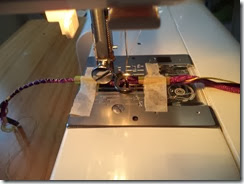
Some cords are narrow and tight, others more haphazard with fringes and loops added.
Particularly like M9 (see labelling on card below) with its loose bits and different spread of zigzags along the length of the cord. Some wanted to twist into shapes ideal for the project (M3 and M13)
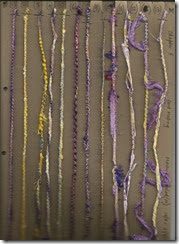
B Twisted cords
This was a manual method where often samples became shorter than in A, initially using two lengths of thread or yarn, tied together one end held in place using the top spool holder the other end twisted using a pencil. The cord was tightly twisted, brought the ends together, holding middle, then released to form varying thicknesses and twists of cord. The ends were then fastened off to keep cord in tact.
Used 60cm and sometimes longer lengths:
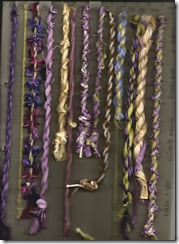
Pleased with the amazing variety of cords.
Liked the fringed effect of T3, the clear twists of the leather and string of T9 and chunkiness of using yarns, threads and strips of suede of T13.
It is difficult to judge the length of threads or yarns needed for a particular length of cord, but it is a quick technique and easy to repeat.
C. Knotted, plaited and wrapped methods
Separate samples were made for each of these techniques
Knotted cords
I started off wrong with this technique, initially just knotting lengths of thread or yarn, then realised that more was required. I have a couple of the mistakes filed, but here is a card showing 8 techniques:
K1 Simple knotted cord regular spaced; K2 irregular spaced; K3 Series of half hitch knots; K4 Square knot using same side; K5 Square knot using alternate sides; K6 Continuous twist chain; K7 Finger cord; K8 Double ridge hitching or alternate chaining
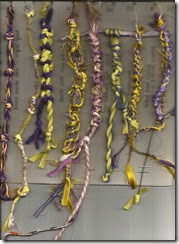
I used different types of thread and yarn including fine metal, and different numbers of strands. It was interesting to find the cord twisted forming a spiral effect when using the same side (K4 and K8), but became flatter using alternate sides (K5), with a distinction possibly between a cord and a braid.
Plaited cords
I was used to making plaits in hair as a child and found it easy using three strands from the back of the plait.
However I soon realised that I needed to adopt a different technique when using four or more strands, and indeed equally for three strands, using a similar approach for each. I used a sponge base to hold pins in place at the top or start of the plait. The pins held each strand in place, then using an over and under approach for the left thread to the right in a consistent way was able to make different designs in the plait. (This I recorded in my notes, taking some photographs to show each stage).
Because cords were required to make these plaits, I used existing cords as in string and wool as well as further machine made or twisted examples.
Here are a series of simple three cord plaits:
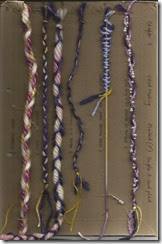
Followed by a series of multiple cord braids:
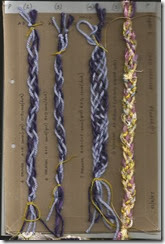
It was very satisfying finding a consistent approach to the plaiting technique; the variety of designs both in the cords and particularly the braids. The braid designs could be made into bracelets, bands or belts.
Another technique that I decided to try was to use a lucet to make very strong cords. I believe it was used in Medieval times. I made some out of cotton thread (like wool) and raffia using variegated yellow or purple, and one colour yellow and purple, some using one thread others using two threads. Gave good results.
Didn’t do so well with the Turk’s Head knot. I was able to make a flat version but not a button or toggle. I wondered whether a Monkey’s paw would produce a better button. I need to practice both techniques as I can see how it can be used in a variety of ways, from the Scout’s toggle, rings and bracelets as well as attractive buttons and heads for tassels.
Wrapped method
For this method I made a lot more twisted cords.
I used one cord or a group of cords for the main core and another cord or group of cords for wrapping. I enjoyed making the five samples.
W1 Single wrap: 1 cord around a 3 cord core; W2 Wrapped loosely and unevenly, twisted cord around a one string core; W3 Single cord wrapped tightly around a soft fat core; W4 Thick cord wrapped with fine thread; W5 Fine cord core wrapped with thicker cord
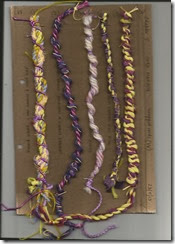
I liked all these techniques and I can see them being laid around a hat or bag.
It was a satisfying experience using these techniques and hope to use some in my final item.
Health & Safety was noted in the notebook.